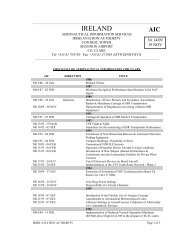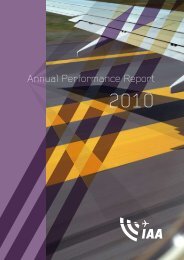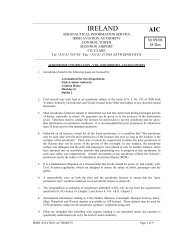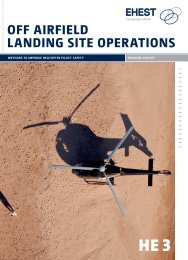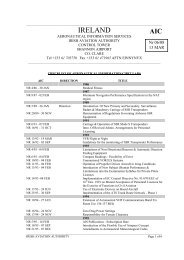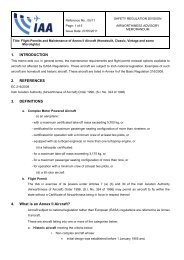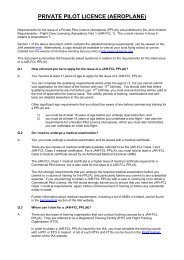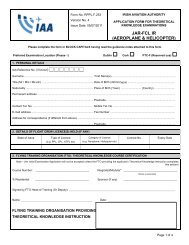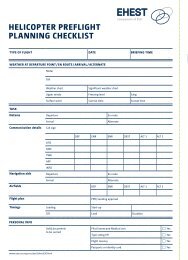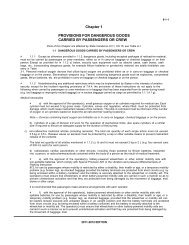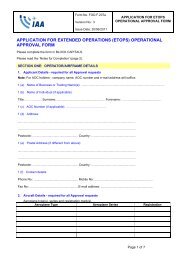Create successful ePaper yourself
Turn your PDF publications into a flip-book with our unique Google optimized e-Paper software.
05 FEB 2015<br />
AIP IRELAND<br />
<strong>ENR</strong> <strong>5.6</strong> - 1<br />
05 FEB 2015<br />
<strong>ENR</strong> <strong>5.6</strong><br />
BIRD MIGRATION AND AREAS WITH SENSITIVE FAUNA<br />
1. BIRD CONCENTRATIONS AND MOVEMENTS IN IRELAND<br />
1.1 All shallow estuaries attract large flocks of feeding and roosting water birds. Inland waters are frequently used as<br />
gull roosts and as refuges by wildfowl and wading birds. Some areas of pasture are utilised by large flocks of feeding<br />
gulls and waders which fly to and from roosts at wetlands. In addition, large numbers of seabirds gather to breed on<br />
exposed headlands, cliffs and offshore islands. Some may visit their breeding sites throughout the year and soar<br />
high above them at times.<br />
1.2 Many species are hazardous to aircraft. Attached maps show the main areas where flocks occur, particularly flocks<br />
of gulls, the birds responsible for most <strong>Irish</strong> bird strikes. The darker areas indicate particularly dense concentrations.<br />
Each marked concentration should be regarded as potentially hazardous out to 20-30miles from its periphery to<br />
allow for dawn and dusk roosting movements. The number of sites where large concentrations of birds are known<br />
to occur is very great but some sites will be occupied for only short periods depending on the season and weather.<br />
Starlings roosts for instance are numerous but they often change position and hence are not shown on the maps:<br />
they are dangerous at dawn and dusk and highly dangerous if they erupt at night as they sometimes do when the<br />
birds migrate.<br />
1.3 It should be noted that the change in bird concentration areas shown on the two maps, as from one period to the<br />
other, is gradual and the greatest movements of birds are witnessed during the changeover periods, e.g. February<br />
and March.<br />
1.4 Migration of birds in Ireland in the spring and autumn is concentrated mainly on the coast. In spring small song-birds,<br />
mainly night-flying, arrive on the South and East coasts and then spread through the country; passage migrants tend<br />
to continue northwards using the East coast as a leading line; at the same time large numbers of sea birds return<br />
from the open seas to the cliffs and offshore islands to breed. In autumn, song-birds from Iceland/Greenland,<br />
Scotland, Scandinavia etc. arrive in large numbers along the North and North-West coasts and concentrations are<br />
again found on the South-East coasts as birds depart from the country. Numbers are far greater in autumn than in<br />
spring. The largest concentrations of waders are found mainly in the larger estuaries all around the coast in spring<br />
and autumn, though some species (plovers, curlews etc.) are found in considerable and concentrations in many<br />
inland sites. Ducks, geese and swans are found in numbers in all major estuaries and many inland wetlands. The<br />
main arrivals in Autumn are on the North and North-West coasts and on the East coast. Swans and geese are found<br />
migrating at some height (up to 2,500ft) on these coasts in OCT/NOV and again from the end of FEB to the end of<br />
APR. Very large scale movements of ducks and waders especially, can be encountered (usually moving East-West)<br />
at any time from NOV to MAR.<br />
1.5 Height data for migratory movements is inadequate but even under favourable conditions most migrants fly below<br />
5,000ft AGL.<br />
1.6 Meteorological conditions play a dominant role in determining the behaviour of birds especially migratory patterns<br />
and routes but also affecting concentrations in feeding areas and routes the occurrence of soaring behaviour.<br />
Disorientation in fog also occurs. The greatest numbers of birds migrate in clear weather and calm conditions or with<br />
a following wind. The biggest movements are initiated by the onset of cold weather in winter. Diurnal migrants depart<br />
at dawn, peak numbers on the move occurring during the first few hours of daylight and falling off during the<br />
day.Nocturnal migrants depart at dusk, peak numbers occurring during hours of darkness, but many may still be<br />
flying at dawn and some species of birds will carry on all day too. Birds which make long sea crossings may not<br />
arrive until after the normal peak migration hours.<br />
2. WEXFORD WILDFOWL WINTERING GROUNDS<br />
NAME LATERAL LIMITS UPPER<br />
LIMIT<br />
NORTH SLOB WEXFORD<br />
HARBOUR<br />
SOUTH SLOB WEXFORD<br />
HARBOUR<br />
Circle 1NM radius centred on<br />
position 5221N 0624W<br />
Circle 1NM radius centres on<br />
position 5217N 0625W<br />
4,000ft<br />
SFC<br />
LOWER<br />
LIMIT<br />
REMARK<br />
Pilots are requested to avoid<br />
the area from 10 OCT to 30<br />
APR<br />
<strong>Irish</strong> <strong>Aviation</strong> <strong>Authority</strong><br />
AIRAC Amdt 001/15
05 FEB 2015<br />
<strong>ENR</strong> <strong>5.6</strong> - 2<br />
05 FEB 2015<br />
AIP IRELAND<br />
AIRAC Amdt 001/15<br />
<strong>Irish</strong> <strong>Aviation</strong> <strong>Authority</strong>
05 FEB 2015<br />
AIP IRELAND<br />
<strong>ENR</strong> <strong>5.6</strong> - 3<br />
05 FEB 2015<br />
<strong>Irish</strong> <strong>Aviation</strong> <strong>Authority</strong><br />
AIRAC Amdt 001/15
05 FEB 2015<br />
<strong>ENR</strong> <strong>5.6</strong> - 4<br />
05 FEB 2015<br />
AIP IRELAND<br />
3. AVOIDANCE OF OVERFLIGHT OF AREAS OF SENSITIVITY<br />
1. While it is not possible to list each area of sensitivity, such areas can, normally, be readily identified from the<br />
air. Examples of areas of sensitivity include nature reserves, bird sanctuaries, national parks, stud farms,<br />
events such as horse and livestock shows, national monuments archaeological sites, etc.<br />
2. Pilots are requested, whenever possible, to pre-plan to avoid flying over or in close proximity to areas of<br />
sensitivity during the course of normal navigation. A local aerodrome should, on request be able to provide<br />
a brief for pilots on areas of local sensitivity.<br />
3. The Table does not include sensitivity places such as hospitals, schools, places of worship, industrial and<br />
commercial complexes, etc., which aircraft should also avoid overflying.<br />
Table 1:<br />
LOCATION IDENTITY COORDINATES SENSITIVE PERIOD<br />
2.5 NM North of Shannon<br />
Airport<br />
Stud Farm<br />
524440N<br />
0085530W<br />
All Year<br />
4NM North-East of Bandon<br />
Co.Cork<br />
Stud Farm<br />
514550N<br />
0084105W<br />
All Year<br />
Rockabill Island, North<br />
Co.Dublin<br />
Nature Reserve<br />
533530N<br />
0060100W<br />
1 May-31Aug<br />
Maidens Rock, Lamb<br />
Island, Dalkey Co.Dublin<br />
Nature Reserve<br />
531630N<br />
0060530W<br />
1 May-30 Sept<br />
The Breaches,<br />
Kilcoole,Co.Wicklow<br />
Nature Reserve<br />
530530N<br />
0060130W<br />
1 May - 30 Aug<br />
North Slob, Wexford<br />
Harbour<br />
Nature Reserve<br />
522100N<br />
0062400W<br />
1 Oct- 30 Apr<br />
South Slob, Wexford<br />
Harbour<br />
Nature Reserve<br />
521700N<br />
0062500W<br />
1 Oct - 30 Apr<br />
Bull Island, Dublin Bay Nature Reserve 532200N<br />
0060900W<br />
All Year<br />
Premises of the Royal<br />
Dublin Society, Ballsbridge<br />
Dublin 4<br />
Horse Show<br />
531936N<br />
0061342W<br />
Week following first<br />
Monday in August<br />
(every year)<br />
Glen of the Downs, Bray<br />
Co.Wicklow<br />
Stud Farm 530917.19N<br />
0060723.53W<br />
All Year<br />
Ballyrouagh<br />
Slieverue<br />
Co.Kilkenny<br />
Stud Farm<br />
521833N<br />
0070203W<br />
All Year<br />
3.1 Reporting of Bird Strikes<br />
3.1.1 General<br />
Annex 14, Volume 1, Aerodromes, requires that the bird strike hazard on, or in the vicinity of, an aerodrome shall<br />
be assessed through the establishment of a national procedure for recording and reporting of bird strikes to aircraft.<br />
As a contracting state to the Chicago Convention, Ireland provides data to for inclusion in the Bird Strike Information<br />
System (IBIS). This is a reporting system designed to collect and disseminate information on bird strikes resulting<br />
from collision between an aircraft and a bird.<br />
In order to compile data for inclusion in the IBIS and to assess the extent of the bird strike hazard in Ireland, pilots<br />
of aircraft involved in a bird strike are requested to complete the Wildlife Strike Reporting Form and submit the form<br />
as soon as practicable to;<br />
AIRAC Amdt 001/15<br />
<strong>Irish</strong> <strong>Aviation</strong> <strong>Authority</strong>
05 FEB 2015<br />
AIP IRELAND<br />
<strong>ENR</strong> <strong>5.6</strong> - 5<br />
05 FEB 2015<br />
Post:<br />
National Bird Hazard Committee,<br />
Aerodromes and Airspace Standards Department,<br />
<strong>Irish</strong> <strong>Aviation</strong> <strong>Authority</strong>,<br />
The Times Building<br />
11-12 D’Olier Street<br />
Dublin 2<br />
Ireland<br />
Fax: +353 1 677 4460<br />
Email:<br />
URL:<br />
Birdstrikes@iaa.ie<br />
http://www.iaa.ie/index.jsp?p=182&n=493<br />
The aircraft operator is requested to complete the Supplementary Wildlife Reporting Form and to submit the<br />
completed form to the above address.<br />
3.1.2 Blank Forms are available<br />
1. at the Airport Operations Office at Shannon Airport;<br />
2. at Airport Duty Offices at other Airports within the state;<br />
3. by application to the <strong>Irish</strong> <strong>Aviation</strong> <strong>Authority</strong>.<br />
In connection with bird strikes on or near <strong>Irish</strong> airports every effort should be made to report the Altitude at which<br />
the strike occurs.<br />
4. DISPLAY OF AIRCRAFT LANDING LIGHTS<br />
It has been shown that the display of landing lights has reduced the number of bird strikes on aircraft. Therefore<br />
where the design limitations of aircraft installations permit, landing lights should be operated in flight within terminal<br />
areas and during take-off, approach-to-land and climb and descent procedures.<br />
<strong>Irish</strong> <strong>Aviation</strong> <strong>Authority</strong><br />
AIRAC Amdt 001/15
05 FEB 2015<br />
<strong>ENR</strong> <strong>5.6</strong> - 6<br />
05 FEB 2015<br />
AIP IRELAND<br />
WILDLIFE STRIKE REPORTING FORM<br />
SEND TO:<br />
National Bird Hazard Committee,<br />
Aeronautical Services Dept,<br />
<strong>Irish</strong> <strong>Aviation</strong> <strong>Authority</strong>,<br />
The Times Building,<br />
11-12 D’Olier Street,<br />
DUBLIN 2.<br />
Operator 01/02 Effect on Flight<br />
None 32<br />
Aircraft Make/Model 03/04 aborted take-off 33<br />
Precautionary landing 34<br />
Engine Make/Model 05/06 engines shut down 35<br />
Other 36<br />
Aircraft Registration 07<br />
Sky Condition<br />
Date No Cloud A<br />
day month year 08 Some Cloud B<br />
Overcast<br />
C<br />
Local Time 09<br />
Precipitation<br />
Dawn Day Dusk Night 10 Fog 38<br />
Rain 39<br />
Aerodrome Name 11/12 Snow 40<br />
Runway Used 13 Bird Species 41<br />
Location if En Route 14 Number of Birds<br />
Seen 42 Struck 43<br />
Height AGL ft 15 1 A A<br />
2-10 B B<br />
Speed (IAS) kts 16 11-100 C C<br />
more D D<br />
Phase of Flight 17<br />
Parked A en route E Size of Bird 44<br />
Taxi B descent F Small S<br />
Take-off run C approach G Medium M<br />
Climb D landing roll H Large L<br />
Part(s) of Aircraft<br />
Pilot Warned of Birds<br />
Random 18 Yes y No x<br />
Windshield 19<br />
Nose (excluding above) 20 Remarks (describe damage, injuries and other<br />
Engine no. 1 21 pertinent information)<br />
2 22<br />
3 23<br />
4 24<br />
Propeller 25<br />
Wing rotor 26<br />
Fuselage 27<br />
Landing gear 28<br />
Tail 29<br />
Lights 30<br />
Other (specify) 31<br />
Reported by<br />
(Optional)<br />
THIS INFORMATION IS REQUIRED FOR AVIATION SAFETY<br />
AIRAC Amdt 001/15<br />
<strong>Irish</strong> <strong>Aviation</strong> <strong>Authority</strong>
05 FEB 2015<br />
AIP IRELAND<br />
<strong>ENR</strong> <strong>5.6</strong> - 7<br />
05 FEB 2015<br />
SUPPLEMENTARY WILDLIFE STRIKE REPORTING FORM<br />
OPERATOR COSTS AND ENGINE DAMAGE INFORMATION<br />
A<br />
Basic Data<br />
Operator 01/02<br />
Aircraft Make/Model 03/04<br />
Engine Make/Model 05/06<br />
Aircraft Registration 07<br />
Date of strike day month year 08<br />
Aerodrome/Location if known 11/12/14<br />
B<br />
Cost Information<br />
Aircraft time out of service hours 52<br />
Estimated cost of repairs or replacement U.S.S (in thousands) 53<br />
Estimated Other Costs U.S.S (in thousands) 54<br />
(e.g. loss of revenue, fuel, hotels)<br />
C<br />
SPECIAL INFORMATION ON ENGINE DAMAGE STRIKES<br />
Engine position number 1 2 3 4<br />
Reason for failure/shutdown 55 58 57 58<br />
Uncontained failure A A A A<br />
Fire B B B B<br />
Shutdown–vibration C C C C<br />
Shutdown–temperature D D D D<br />
Shutdown–fire warning E E E E<br />
Shutdown–other (specify) Y Y Y Y<br />
Shutdown-unknown Z Z Z Z<br />
Estimated percentage of thrust loss* 59 60 81 82<br />
Estimated number of birds ingested 63 64 65 56<br />
Bird Species 41<br />
* These may be difficult to determine but even estimates are useful.<br />
Retain all bird remains including feather fragments at airport of occurrence<br />
Reported by<br />
<strong>Irish</strong> <strong>Aviation</strong> <strong>Authority</strong><br />
AIRAC Amdt 001/15
05 FEB 2015<br />
<strong>ENR</strong> <strong>5.6</strong> - 8<br />
05 FEB 2015<br />
AIP IRELAND<br />
THIS PAGE INTENTIONALLY LEFT BLANK<br />
AIRAC Amdt 001/15<br />
<strong>Irish</strong> <strong>Aviation</strong> <strong>Authority</strong>




